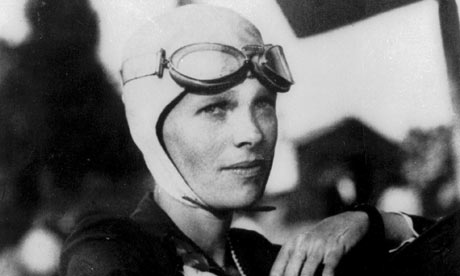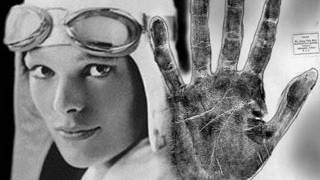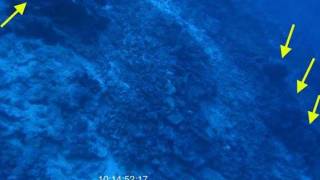Bones Riddle of Amelia Earhart
Source: guardian.co.uk
Finger may point to solution in Amelia Earhart disappearance riddle The riddle of Amelia Earhart’s disappearance has only grown more complex in the 73 years since the first woman to fly solo across the Atlantic went missing attempting to fly around the equator.
The riddle of Amelia Earhart’s disappearance has only grown more complex in the 73 years since the first woman to fly solo across the Atlantic went missing attempting to fly around the equator.One theory had it that she crashed into the sea after running out of fuel during her expedition over the Pacific Ocean. Others claimed that Earhart was executed by the Japanese for spying, was pressed into making propaganda broadcasts from Tokyo during the war, or that she secretly returned to the US under an assumed identity.
But now an array of artefacts from the 1930s and bones found on the uninhabited Pacific atoll of Nikumaroro suggest that Earhart and her navigator, Fred Noonan, endured lingering deaths as castaways on a desert island and were eventually eaten by crabs.
Researchers from The International Group for Historic Aircraft Recovery (Tighar) found what appears to be a phalanx from a finger and two other bones, one of them from the neck, alongside a host of other clues after two decades and 10 expeditions attempting to solve the mystery.
The suspected finger is being tested for human DNA. It may turn out to be from a turtle – which have similar bones in their flippers.
But the other discoveries lend credence to the theory that Earhart died on the atoll after going missing en route to Howland Island in July 1937 at the age of 41 – she was declared legally dead 18 months later.
They include part of a mirror from a woman’s compact, a zip from a Pennsylvania factory and travel-sized bottles made in New Jersey as well as a pocket knife listed on her aircraft’s inventory, all manufactured in the 1930s.
Alongside the goods are the remains of small fires with bird and fish bones, and empty oyster shells laid out in a row as if to collect water, suggesting someone was trying to survive on the island.
Three years after Earhart disappeared British colonial authorities, who then administered Nikumaroro, found 13 bones from a human skeleton at the site of the latest discoveries. The bones were later assessed to be "more likely female than male" and "more likely white than Polynesian or other Pacific Islander". Those bones have since been lost.
Ric Gillespie, the executive director of Tighar, said the combined evidence points to Earhart dying on Nikumaroro.
"The bottom line is we have this archaeological site on this island where so much other evidence points to the Earhart flight having ended up. We know there was this castaway found there who appears to have been an American woman of the 1930s and there’s only one of those missing out there," he said.
Gillespie said that the condition of some of the discoveries added to the evidence that there were people attempting to survive on the island.
"We could see that the knife had been beaten apart with a blunt object … apparently in order to remove the blades. We can only speculate but if you’re a castaway and you need to make a spear to catch fish, maybe the blades are more useful that way than still attached to the knife," he said.
Gillespie said a member of Earhart’s family had provided a DNA sample for testing if the suspected finger bone turned out to be human.
But he added that the family would prefer a different ending to the Amelia Earhart story.
"A crash at sea, that’s nice and clean and a quick ending. Ending up as a castaway on a waterless atoll, and struggling to survive for a time and failing and ultimately being eaten by crabs is not nearly as pretty. They’re hoping that we’re wrong and I can’t blame them for that," said Gillespie.
Article from: guardian.co.uk

Amelia Earhart’s Fate: The Archaeological Investigations
By Thomas F. King | About.com/Archaeology
[...]
In 1991, Ric Gillespie got the idea that a very small grave we’d found near the middle of the south side of the island was where the colonists had buried Earhart’s bones. The origin of this strange notion was a story told by a former Coast Guardsman, Floyd Kilts, to a San Diego Tribune reporter in 1960. Kilts--dead by the time we learned of the story--had said he was sure that Earhart had wound up on Nikumaroro, because when he was there in 1946 a “native” had told him of finding human bones and a “woman’s shoe, American kind” on the island. The “Irish magistrate,” he said, had “thought of Earhart right away,” and set out to row the bones to Fiji in the island’s four-oared boat. But he had died en route, and the “superstitious natives” had thrown the bones overboard.
A strange story, and we speculated a lot about it. When the isolated grave turned up, Ric speculated about that, too. Why so far from the village? Why in such an isolated place? Why so small? Maybe the bones had been disarticulated, and maybe the colonists were afraid of the ghost that might be attached to them. Maybe they were the bones Kilts had heard about.
So Ric got permission from the government to excavate the grave, and in 1991 a TIGHAR team landed on the island to do so. They excavated it with all the care that archaeology requires, and all the respect due a dead person, and found the remains of an infant. So much for that; they put the bones back, and filled in the grave.
But while they were doing so, one of the team members, Tommy Love, was changing his boots when a small coconut crab ran under his legs and turned over a leaf, exposing the heel of a shoe. The heel was embossed with the name “Cat’s-Paw”--an American brand. Detailed search of the vicinity revealed the fragmentary sole associated with the heel, and the heel of a different shoe. The sole-heel combination were the remains of a woman’s blucher-style oxford, dating--said shoe experts--to the 1930s or thereabouts--while the other heel was from a man’s shoe.
Earhart wore blucher-style oxfords; we have pictures. But it appears in the pictures that her shoes were smaller than the one found on the island. But we know from news accounts of her flight that she carried at least a couple of pairs of shoes. Was one pair more commodious than another, perhaps to accommodate heavy socks when flying? We don’t know. The shoe parts remain in TIGHAR’s collection, the subjects of endless speculation.
The Seven Site
The place on the island where we’ve done the most intensive archaeological fieldwork is called the Seven Site--because of a natural seven-shaped clearing in the Scaevola that covers it. The Seven Site is near the southeast end of the island on the windward (northeast) side, about a quarter mile northwest of the old Coast Guard station, about two miles southeast of the village and across the lagoon. There’s a colonial-era water tank there, a scatter of artifacts, and a hole in the ground.
In1997, New Zealand TIGHAR member Peter McQuarrie was doing research in the Kiribati National Archives on Tarawa for his World War II history book Conflict in Kiribati, and came upon a file titled “Skeleton, Human, finding of on Gardner Island.” It contained copies of 1940-41 wireless traffic between Gallagher on Nikumaroro and his superiors, mostly in Fiji, about the discovery of a partial human skeleton near the southeast end of the island. The bones were associated with a woman’s shoe and a sextant box, as well as a Benedictine bottle and the remains of a fire with bird and turtle bones. Gallagher thought they might represent the remains of Earhart.
So Kilts had not been completely off-base, but instead of rowing the bones to Fiji, Gallagher had searched the site and sent the bones to Fiji on a small ship that serviced the islands. There they were examined by Dr. David Hoodless, who decided they represented a male, of European or mixed ethnicity. Further research in England turned up Dr. Hoodless’ notes, with measurements of the bones.http://anthro.dac.uga.edu TIGHAR turned these over to forensic anthropologists Karen Burns and Richard Jantz, who applied the modern forensic program FORDISC, and concluded--with lots of caveats--that the bones appeared to have been most like those an adult woman of European ethnicity, about Earhart’s height.
Read the full article at: archaeology.about.com
Finger may point to solution in Amelia Earhart disappearance riddle
 The riddle of Amelia Earhart’s disappearance has only grown more complex in the 73 years since the first woman to fly solo across the Atlantic went missing attempting to fly around the equator.
The riddle of Amelia Earhart’s disappearance has only grown more complex in the 73 years since the first woman to fly solo across the Atlantic went missing attempting to fly around the equator.One theory had it that she crashed into the sea after running out of fuel during her expedition over the Pacific Ocean. Others claimed that Earhart was executed by the Japanese for spying, was pressed into making propaganda broadcasts from Tokyo during the war, or that she secretly returned to the US under an assumed identity.
But now an array of artefacts from the 1930s and bones found on the uninhabited Pacific atoll of Nikumaroro suggest that Earhart and her navigator, Fred Noonan, endured lingering deaths as castaways on a desert island and were eventually eaten by crabs.
Researchers from The International Group for Historic Aircraft Recovery (Tighar) found what appears to be a phalanx from a finger and two other bones, one of them from the neck, alongside a host of other clues after two decades and 10 expeditions attempting to solve the mystery.
The suspected finger is being tested for human DNA. It may turn out to be from a turtle – which have similar bones in their flippers.
But the other discoveries lend credence to the theory that Earhart died on the atoll after going missing en route to Howland Island in July 1937 at the age of 41 – she was declared legally dead 18 months later.
They include part of a mirror from a woman’s compact, a zip from a Pennsylvania factory and travel-sized bottles made in New Jersey as well as a pocket knife listed on her aircraft’s inventory, all manufactured in the 1930s.
Alongside the goods are the remains of small fires with bird and fish bones, and empty oyster shells laid out in a row as if to collect water, suggesting someone was trying to survive on the island.
Three years after Earhart disappeared British colonial authorities, who then administered Nikumaroro, found 13 bones from a human skeleton at the site of the latest discoveries. The bones were later assessed to be "more likely female than male" and "more likely white than Polynesian or other Pacific Islander". Those bones have since been lost.
Ric Gillespie, the executive director of Tighar, said the combined evidence points to Earhart dying on Nikumaroro.
"The bottom line is we have this archaeological site on this island where so much other evidence points to the Earhart flight having ended up. We know there was this castaway found there who appears to have been an American woman of the 1930s and there’s only one of those missing out there," he said.
Gillespie said that the condition of some of the discoveries added to the evidence that there were people attempting to survive on the island.
"We could see that the knife had been beaten apart with a blunt object … apparently in order to remove the blades. We can only speculate but if you’re a castaway and you need to make a spear to catch fish, maybe the blades are more useful that way than still attached to the knife," he said.
Gillespie said a member of Earhart’s family had provided a DNA sample for testing if the suspected finger bone turned out to be human.
But he added that the family would prefer a different ending to the Amelia Earhart story.
"A crash at sea, that’s nice and clean and a quick ending. Ending up as a castaway on a waterless atoll, and struggling to survive for a time and failing and ultimately being eaten by crabs is not nearly as pretty. They’re hoping that we’re wrong and I can’t blame them for that," said Gillespie.
Article from: guardian.co.uk

Amelia Earhart’s Fate: The Archaeological Investigations
By Thomas F. King | About.com/Archaeology
[...]
In 1991, Ric Gillespie got the idea that a very small grave we’d found near the middle of the south side of the island was where the colonists had buried Earhart’s bones. The origin of this strange notion was a story told by a former Coast Guardsman, Floyd Kilts, to a San Diego Tribune reporter in 1960. Kilts--dead by the time we learned of the story--had said he was sure that Earhart had wound up on Nikumaroro, because when he was there in 1946 a “native” had told him of finding human bones and a “woman’s shoe, American kind” on the island. The “Irish magistrate,” he said, had “thought of Earhart right away,” and set out to row the bones to Fiji in the island’s four-oared boat. But he had died en route, and the “superstitious natives” had thrown the bones overboard.
A strange story, and we speculated a lot about it. When the isolated grave turned up, Ric speculated about that, too. Why so far from the village? Why in such an isolated place? Why so small? Maybe the bones had been disarticulated, and maybe the colonists were afraid of the ghost that might be attached to them. Maybe they were the bones Kilts had heard about.
So Ric got permission from the government to excavate the grave, and in 1991 a TIGHAR team landed on the island to do so. They excavated it with all the care that archaeology requires, and all the respect due a dead person, and found the remains of an infant. So much for that; they put the bones back, and filled in the grave.
But while they were doing so, one of the team members, Tommy Love, was changing his boots when a small coconut crab ran under his legs and turned over a leaf, exposing the heel of a shoe. The heel was embossed with the name “Cat’s-Paw”--an American brand. Detailed search of the vicinity revealed the fragmentary sole associated with the heel, and the heel of a different shoe. The sole-heel combination were the remains of a woman’s blucher-style oxford, dating--said shoe experts--to the 1930s or thereabouts--while the other heel was from a man’s shoe.
Earhart wore blucher-style oxfords; we have pictures. But it appears in the pictures that her shoes were smaller than the one found on the island. But we know from news accounts of her flight that she carried at least a couple of pairs of shoes. Was one pair more commodious than another, perhaps to accommodate heavy socks when flying? We don’t know. The shoe parts remain in TIGHAR’s collection, the subjects of endless speculation.
The Seven Site
The place on the island where we’ve done the most intensive archaeological fieldwork is called the Seven Site--because of a natural seven-shaped clearing in the Scaevola that covers it. The Seven Site is near the southeast end of the island on the windward (northeast) side, about a quarter mile northwest of the old Coast Guard station, about two miles southeast of the village and across the lagoon. There’s a colonial-era water tank there, a scatter of artifacts, and a hole in the ground.
In1997, New Zealand TIGHAR member Peter McQuarrie was doing research in the Kiribati National Archives on Tarawa for his World War II history book Conflict in Kiribati, and came upon a file titled “Skeleton, Human, finding of on Gardner Island.” It contained copies of 1940-41 wireless traffic between Gallagher on Nikumaroro and his superiors, mostly in Fiji, about the discovery of a partial human skeleton near the southeast end of the island. The bones were associated with a woman’s shoe and a sextant box, as well as a Benedictine bottle and the remains of a fire with bird and turtle bones. Gallagher thought they might represent the remains of Earhart.
So Kilts had not been completely off-base, but instead of rowing the bones to Fiji, Gallagher had searched the site and sent the bones to Fiji on a small ship that serviced the islands. There they were examined by Dr. David Hoodless, who decided they represented a male, of European or mixed ethnicity. Further research in England turned up Dr. Hoodless’ notes, with measurements of the bones.http://anthro.dac.uga.edu TIGHAR turned these over to forensic anthropologists Karen Burns and Richard Jantz, who applied the modern forensic program FORDISC, and concluded--with lots of caveats--that the bones appeared to have been most like those an adult woman of European ethnicity, about Earhart’s height.
Read the full article at: archaeology.about.com






















